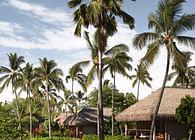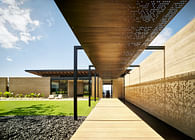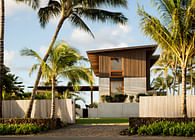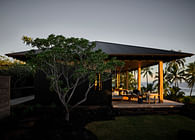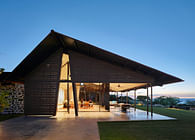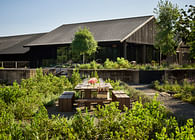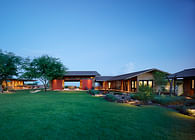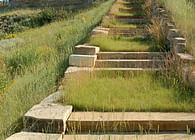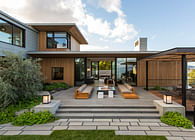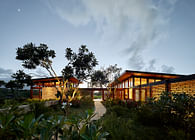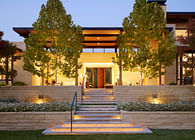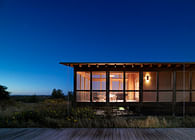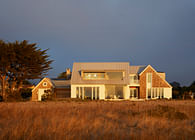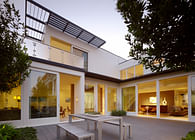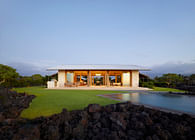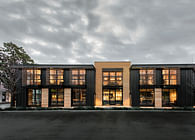
San Francisco, CA
For anyone who has never visited Hawaii’s Big Island, it can be surprising to discover that a vast arid plain occupies a significant portion of its western side, sloping gently down from the Hualalai Mountain to the coastline. Tufts of golden-green grass spring from the crumbled bed of black lava rock, with lacy Kiawe trees scattered throughout. When Walker Warner Architects was asked to design a vacation home in this setting, the design team decided to fully embrace the quiet beauty of this unique landscape. The project was named Hale Mau’u. In Hawaiian, hale (pronounced ha-lay) means house, and mau’u is a type of native grass.
The 2.9-acre site had several innate qualities — such as its location at the end of a cul-de-sac and its long driveway approach — that allowed the team to create what architect Greg Warner refers to as “an illusion of isolation.” In his words, “This site is unique in its ability to capture the ocean view and mountain view simultaneously. Not all parcels get that. The arrangement of the 4,817-square-foot compound had to do three things: catch the mountain view, catch the ocean view, and then block the view of the neighboring houses.”
From overhead, the site strategy is clear. A single raised boardwalk, floating respectfully above the ground, forms a linear axis pointing towards the mountains on one side and the ocean on the other. This pathway runs through a grassy courtyard, and around three sides of this central space the long, low hales are loosely clustered, like a village. On the fourth side of the courtyard lies the swimming pool, with a view of the ocean beyond, and the island of Maui rising up on the horizon.
According to Warner, the clients made it clear from the beginning what they really wanted: “A house like no other. Resort community architecture tends to fall back on a commonality of building types, but these clients wanted something very unique.” With this open attitude, they bought in immediately to the idea that a home on the dry side of Hawaii could provide circulation between rooms entirely on the outside, using covered walkways that wrap around each of the individual structures. The first building you encounter is the main hale (2,318 square feet), which contains the shared spaces: living room, kitchen, and family room. Passing through this building you arrive at the courtyard, and flanking the courtyard on both sides are the living quarters: on one side, a single hale for the grand bedroom suite (995 square feet), on the other, a long hale with a row of additional bedroom suites for family and guests (1,504 square feet). Each bedroom opens directly onto the central lawn. Each of the en suite bathrooms has its own shower (five in all), and uniquely, not a single shower is indoors.
All of the main rooms, including the bedrooms, are equipped with large barn doors, so that when fully opened there is little distinction between inside and out. The living room has this feature on both sides, allowing the landscape to sweep through the house from the mountains down to the sea. These doors were fabricated with gapped boards, so that when they are closed for privacy or shade, fresh air and light can still filter through. When lit from inside at night, the open gaps give the buildings a resemblance to warm glowing lanterns.
Perhaps the most striking and original visual element of the project is the roofs, which are long gables with eaves designed to be narrow at one end of the building but wide at the other, carefully oriented to provide extra shade where it is most needed. The roof cladding material is copper with standing seams, but laid up in random widths. This technique converts the appearance from something fairly common and utilitarian, to something intriguing and vaguely organic, which Warner describes as being similar in texture to the trunk of a coconut palm.
If the goal was “a house like no other,” then by every measure, Hale Mau’u is a success. Its extraordinary natural surroundings, its novel approach to site design, and its remarkable custom detailing all add up to a one-of-a-kind island retreat. Both unique, and uniquely Hawaiian.
Status: Built
Location: Big Island, Hawaii
Firm Role: Architect
Additional Credits: Landscape: David Y. Tamura Associates; Builder: Metzler Contracting Co. LLC; Lighting Design: Anna Kondolf Lighting Design; Structural Engineering: GFDS Engineers; Mechanical Engineering: Hakalau Engineering, LLC; Electrical Engineering: Morikawa & Associates, LLC; Civil Engineering: Aina Engineers Inc.; Geotechnical Engineering: Geolabs, Inc

